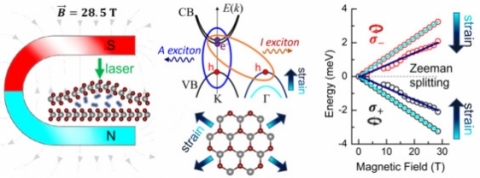Strained, not stirred... Hybridisation of 2D excitons by stretching

Hybridisation is a ubiquitous phenomenon, playing a crucial role within many seemingly disparate contexts such as chemical-bond formation, light-matter interaction and coupling between discrete states in quantum applications. In condensed matter, and especially in semiconductors, hybridisation is a fortunate occurrence, providing a tool for engineering the energies and symmetries of the quantum states of the crystal, continually leading to the observation of novel phenomena and to optimised device performances.
Hybridisation phenomena, though, and their potential have not been fully unleashed in In two-dimensional (2D) semiconductor crystals. These materials represent a recent change of paradigm in solid state physics, initiated by the discovery of graphene. Indeed, 2D semiconductors feature a number of properties that traditional semiconductors lack.
Their all-surface nature makes 2D materials extremely resilient to strain, with high potential for flexible devices.
In a paper published in Physical Review Letters, Elena Blundo and co-authors show that stretching 2D crystals impacts strongly also on the magnetic moments of excitons (the analogue of the hydrogen atom in
semiconductors) that can act as the quantum binary information carriers, e.g., in light emitting devices. The research, coordinated by the group of Antonio Polimeni and Marco Felici, involved several theoretical and experimental groups abroad. 2D crystals were subjected to a strong mechanical deformation thanks to the creation of atomically thin microbubbles filled with highly pressurised hydrogen gas. The ensuing strain of the bubbles engenders controllable on/off-resonance conditions between exciton energy levels, which eventually hybridise.
The gathering of compelling evidence of this fundamental, yet subtle phenomenon required the use of intense magnetic fields (up to 28.5 T) at the European Magnetic Field Laboratory (EMFL) facilities in the Netherlands and in Poland. The unprecedented combination of high magnetic and strain fields with optical measurements featuring sub-micron spatial resolution revealed an unpredicted dependence of the exciton Zeeman splitting on strain. Advanced theoretical methods reproduced accurately the unexpected strain dependence of the exciton gyromagnetic factor (the equivalent of Landé factor for atoms), thus unveiling the underlying exciton hybridisation.
The evidence of exciton hybridisation in a 2D system is not only crucial for future quantum electronics applications of 2D materials, but it also opens the doors to new research in the field, wherein, e.g., exciton hybridization could influence the charge-carrier lifetime and radiative efficiency or could represent an important ingredient in understanding the coupling between different materials in 2D heterostructures.
Authors:
Elena Blundo, Marco Felici, Antonio Polimeni
Reference:
Physical Review Letters
